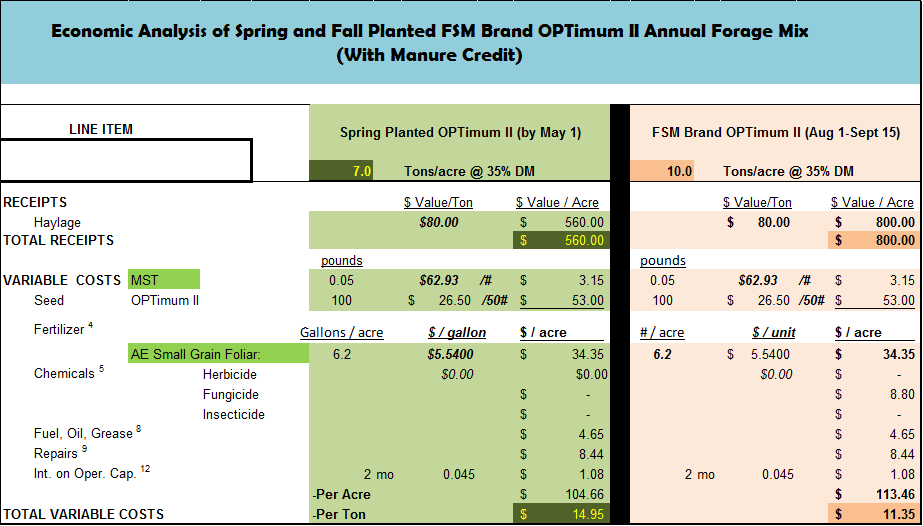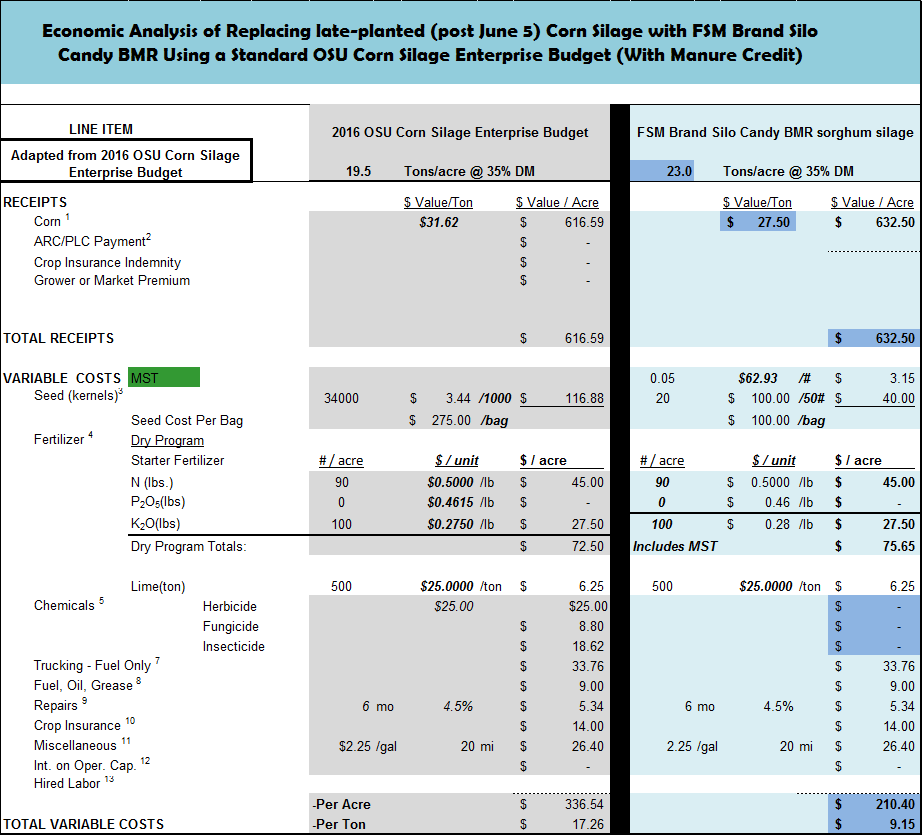Top Alfalfa Genetics
As previously mentioned alfalfa has been and continues to be a staple in dairy production in the United States. Advancements are continually being made in yield, disease resistance, root and crown type as well as leaf-to-stem ratio characteristics using conventional plant breeding techniques.
In recent years, increasing attention has been given to herbicide resistance and other traits associated with a hefty ‘tech’ fee. Alfalfa breeding in North America is done by a handful of companies-nearly every alfalfa marketer sources their material from these few.
Like everyone else, Fowler Seed Marketing sources ‘best available’ alfalfa genetics. The difference is that we sell them at very competitive prices. Following is an economic comparison based on University testing of top performing varieties.

Higher Yields
FSM Brand alfalfas are selected from the best available varieties developed by North American alfalfa breeders just like the top national and regional brands. In multi-year University trials, FSM Brand 414-BR averaged 8.7% higher yield ($117.60 greater value per acre) compared to the 4 national brand competitors noted in the footnote. The advantage versus individual varieties ranged from 3% to 16% over 3 to 7 year trials.
Less Expensive to Establish
In addition to a performance advantage, FSM Brand alfalfas are less expensive to establish. While loyalty, volume, early order and prepay discounts influence the final cost, FSM Brand alfalfa will still be about $10 to $12 per acre less than the top national and regional brands. The bottom-line is a $2.26 per ton savings over the life of the stand (up to $135-$140 per acre over 4 years).
Cover Crops for High-Quality Feed
Environmental concerns have prompted many livestock producers to be aware of keeping a crop growing in every field every month of the year as much as possible. Given the tight economic situation of most diaries, it doesn’t make sense to grow a ‘cover crop’ that doesn’t make high-quality feed.
Oat-pea mixes have been around since I entered the industry over 25 years ago; however, the best ones are far more than grain oats and some random variety of field peas. Following is an example of the economic advantages of our FSM Brand OPTimum II annual forage mix based on performance data.

FSM Brand OPTimum II is an ideal blend of 65% high-yielding forage oats and 35% heat-tolerant forage peas that has demonstrated outstanding feed quality in trials and on the farm. Spring and fall yields are based on our on-farm experience in northern Ohio. The value is based on the current auction price of high quality baleage.
Excellent Return on Investment
The proprietary forage oats in OPTimum II have exhibited superior performance in University trials yielding 7.6 Tons / acre (@ 65% moisture) with 14.1% Crude Protein, 51% NDF (74.7% dNDF), 2.89% lignin and an RFQ of 196. The forage peas add tonnage, supply nitrogen and increase the protein content of the forage by about 4%. In a manure system, OPTimum II will return 5 ½ to 7 times the $11 to $15/acre invested as both a rotational forage and cover crop.
When the Weather Won’t Cooperate
Weather often messes with our planting and harvest plans. When corn planting is delayed into June, dairy producers are faced with the significant investment of planting corn and hoping for enough heat to finish it or finding a comparable alternative. FSM Brand Silo Candy BMR is the alternative! Following is an economic comparison of late planted corn silage compared to Silo Candy BMR.

FSM Brand Silo Candy BMR is a cross between a high-tonnage, sweet BMR forage sorghum and a high-yield grain sorghum that has demonstrated superior silage performance compared with late planted (post June 5th in Ohio) corn silage, especially in dryer than normal seasons.
Increased Tonnage
Silo Candy BMR planted near the end of June this year (2017) yielded 23 Tons / acre. Higher yields have been noted in past years but not measured. A lot of late planted corn silage in northern Ohio didn’t make 20 tons / acre this year.
Good Quality Feed for Half the Cost
TTNDFD for Silo Candy BMR was 51.7 (anything above 43 is good) with NFC at 33.5 (not as much grain as corn). The silage value per ton reflects a calculated milk per ton of 800 pounds less than average corn silage. Experience has shown that Silo Candy BMR feeds much better than it tests. Based on yield and test data the value of silage harvested is similar between Silo Candy BMR and late-planted corn silage; however, production costs are 37.5% ($126.04 /acre) lower partly due to no need for herbicide, fungicide or insecticide. The bottom-line is that superior tonnage of high digestible energy, low-grain silage can be produced for less than $10 /ton (about ½ the production cost of corn silage in a manure system).
For more information about FSM Brand alfalfa or annual forage products click on the provided links. For an individual consultation about how to make these products work on your farm, email support@dairy4profit.com, call (888) 249-SEED or visit the DEALER page on our website www.fowlerseed.com/dealers to contact a dealer in your area.

